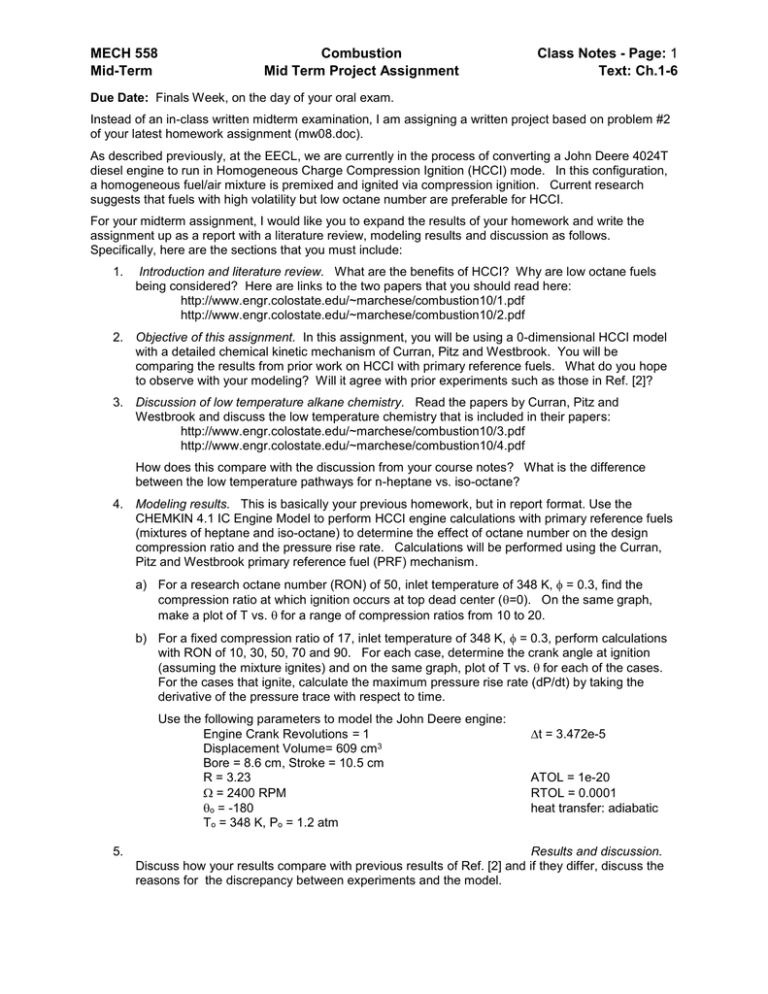midterm10.doc
advertisement

MECH 558 Mid-Term Combustion Mid Term Project Assignment Class Notes - Page: 1 Text: Ch.1-6 Due Date: Finals Week, on the day of your oral exam. Instead of an in-class written midterm examination, I am assigning a written project based on problem #2 of your latest homework assignment (mw08.doc). As described previously, at the EECL, we are currently in the process of converting a John Deere 4024T diesel engine to run in Homogeneous Charge Compression Ignition (HCCI) mode. In this configuration, a homogeneous fuel/air mixture is premixed and ignited via compression ignition. Current research suggests that fuels with high volatility but low octane number are preferable for HCCI. For your midterm assignment, I would like you to expand the results of your homework and write the assignment up as a report with a literature review, modeling results and discussion as follows. Specifically, here are the sections that you must include: 1. Introduction and literature review. What are the benefits of HCCI? Why are low octane fuels being considered? Here are links to the two papers that you should read here: http://www.engr.colostate.edu/~marchese/combustion10/1.pdf http://www.engr.colostate.edu/~marchese/combustion10/2.pdf 2. Objective of this assignment. In this assignment, you will be using a 0-dimensional HCCI model with a detailed chemical kinetic mechanism of Curran, Pitz and Westbrook. You will be comparing the results from prior work on HCCI with primary reference fuels. What do you hope to observe with your modeling? Will it agree with prior experiments such as those in Ref. [2]? 3. Discussion of low temperature alkane chemistry. Read the papers by Curran, Pitz and Westbrook and discuss the low temperature chemistry that is included in their papers: http://www.engr.colostate.edu/~marchese/combustion10/3.pdf http://www.engr.colostate.edu/~marchese/combustion10/4.pdf How does this compare with the discussion from your course notes? What is the difference between the low temperature pathways for n-heptane vs. iso-octane? 4. Modeling results. This is basically your previous homework, but in report format. Use the CHEMKIN 4.1 IC Engine Model to perform HCCI engine calculations with primary reference fuels (mixtures of heptane and iso-octane) to determine the effect of octane number on the design compression ratio and the pressure rise rate. Calculations will be performed using the Curran, Pitz and Westbrook primary reference fuel (PRF) mechanism. a) For a research octane number (RON) of 50, inlet temperature of 348 K, = 0.3, find the compression ratio at which ignition occurs at top dead center (=0). On the same graph, make a plot of T vs. for a range of compression ratios from 10 to 20. b) For a fixed compression ratio of 17, inlet temperature of 348 K, = 0.3, perform calculations with RON of 10, 30, 50, 70 and 90. For each case, determine the crank angle at ignition (assuming the mixture ignites) and on the same graph, plot of T vs. for each of the cases. For the cases that ignite, calculate the maximum pressure rise rate (dP/dt) by taking the derivative of the pressure trace with respect to time. Use the following parameters to model the John Deere engine: Engine Crank Revolutions = 1 Displacement Volume= 609 cm3 Bore = 8.6 cm, Stroke = 10.5 cm R = 3.23 = 2400 RPM o = -180 To = 348 K, Po = 1.2 atm 5. t = 3.472e-5 ATOL = 1e-20 RTOL = 0.0001 heat transfer: adiabatic Results and discussion. Discuss how your results compare with previous results of Ref. [2] and if they differ, discuss the reasons for the discrepancy between experiments and the model.

